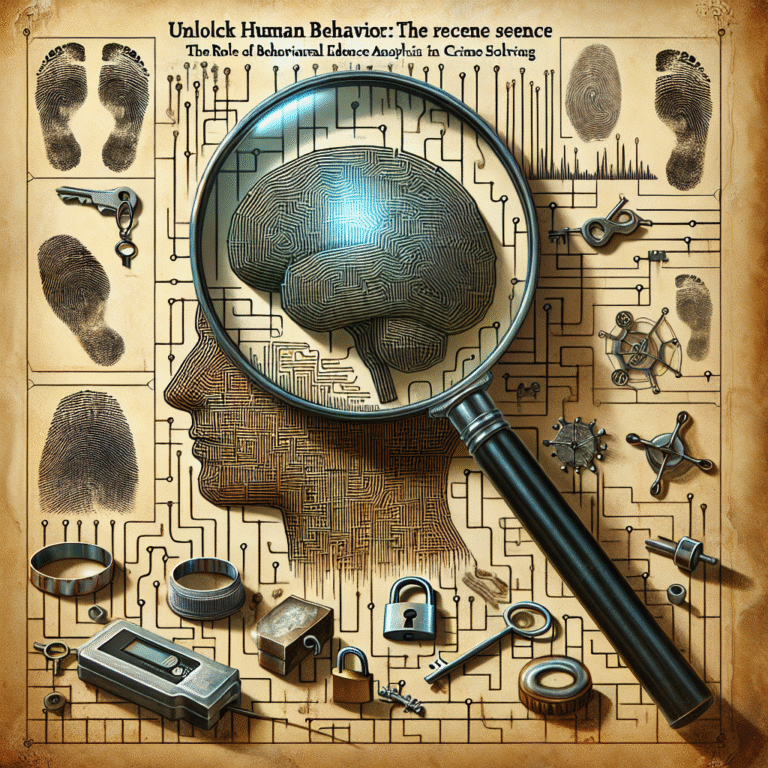
Introduction
In today’s digital age, the intersection of technology and law enforcement is more crucial than ever. As crime increasingly evolves and becomes more sophisticated, law enforcement agencies are turning to data analytics to enhance their investigative techniques. From Data to Insights: The Role of Behavioral Evidence Analysis in Law Enforcement is critical in this transformation. Understanding human behavior through data not only helps solve crimes but also aids in preventing them. This article delves into the nuances of behavioral evidence analysis, its importance in law enforcement, and how it can transform raw data into actionable insights.
What is Behavioral Evidence Analysis?
Behavioral evidence analysis (BEA) refers to the study of human behavior through patterns and data to draw insights about individuals or groups involved in criminal activities. This technique combines psychology, criminology, and forensic science to develop a deeper understanding of criminal behavior. Here are key elements that define BEA:
1. Understanding Human Psychology
At its core, BEA is rooted in psychology. It examines the motives and emotions that drive individuals to commit crimes. By understanding the psychological profiles of offenders, law enforcement can better predict future behaviors or even intervene before a crime occurs.
2. Data-Driven Insights
Utilizing quantitative data, such as crime statistics, demographic information, and victimology, law enforcement can develop comprehensive profiles of potential offenders. This data, when analyzed correctly, leads to actionable insights that can significantly enhance the efficacy of crime prevention strategies.
3. Integration of Various Disciplines
BEA draws on techniques from various fields including sociology, anthropology, and behavioral economics. This multidisciplinary approach allows for a well-rounded analysis that considers various aspects of human behavior, making it versatile in law enforcement contexts.
The Importance of Behavioral Evidence Analysis in Law Enforcement
Enhancing Crime Prevention Strategies
With data analysis, police departments can identify patterns and trends that may go unnoticed. For instance, by analyzing previous crime data, law enforcement agencies can predict potential crime hotspots and deploy resources preemptively.
Case Study: Predictive Policing in Los Angeles
In 2010, the LAPD introduced a predictive policing initiative called "PredPol." By utilizing historical crime data, the algorithm identifies areas at higher risk for criminal activity. This approach has reportedly reduced property crimes by up to 13% in targeted areas. This case exemplifies From Data to Insights: The Role of Behavioral Evidence Analysis in Law Enforcement as it showcases the application of data-driven insights to achieve tangible results.
Understanding and Profiling Offenders
Behavioral evidence analysis allows investigators to build psychological profiles of offenders, leading to more focused investigations. By understanding the behaviors and motivations behind certain crimes, law enforcement can create targeted strategies for apprehending suspects.
Case Study: The Unabomber Case
The FBI’s Behavioral Analysis Unit played a significant role in developing a profile of the Unabomber, Ted Kaczynski. By analyzing his psychological make-up and writing style, they were able to narrow down potential suspects, demonstrating how BEA can provide essential insights in high-profile investigations.
Increasing Conviction Rates
By leveraging behavioral evidence, law enforcement can strengthen cases against suspect through more informed investigations. When behavioral patterns and psychological profiles are well understood, they can directly influence jury perceptions and court outcomes.
Case Study: The BTK Killer
Dennis Rader eluded capture for decades until a closer analysis of his behavioral patterns helped police pinpoint him as a suspect. In 2005, law enforcement agencies utilized behavioral profiling strategies that ultimately led to his arrest and conviction. This illustrates how From Data to Insights: The Role of Behavioral Evidence Analysis in Law Enforcement is integral to achieving justice.
Tools and Technologies Enhancing Behavioral Analysis
Data Mining Software
Law enforcement agencies today utilize various software tools that streamline data collection and analysis. Tools like IBM’s SPSS and Palantir enable easy integration of disparate data sources, allowing officers to analyze data more effectively.
Geographic Information Systems (GIS)
GIS technology helps law enforcement visualize crime patterns geographically. By combining crime data with geographical analysis, police can identify trends related to location, leading to more effective resource allocation.
Behavioral Analysis Tools
Specialized software often includes modules for behavioral modeling, which helps law enforcement profile criminal actions in detailed ways that traditional methods could not support.
Data-Driven Policies Impacting Law Enforcement
Training and Education
Many police departments are incorporating behavioral analysis elements into their training programs. By teaching officers how to interpret data-driven insights, they become better equipped to handle investigations proactively.
Community Policing
Behavioral evidence analysis fosters trust and collaboration between police and communities. Understanding community dynamics and behaviors allows law enforcement to craft policies that address specific community concerns, leading to increased public support and cooperation.
Case Study: Community Engagement in Newark, New Jersey
After a series of violent incidents, the Newark Police Department employed BEA to analyze community sentiments and behaviors. By establishing transparent communication methods and listening sessions, they strengthened community ties, which ultimately reduced crime rates. This case underscores the effectiveness of integrating From Data to Insights: The Role of Behavioral Evidence Analysis in Law Enforcement to foster a cooperative community environment.
Challenges in Implementing Behavioral Evidence Analysis
Data Privacy Issues
With the rise of big data comes the responsibility of managing personal information. Law enforcement agencies must navigate privacy concerns while still leveraging data analytics for crime prevention. Balancing public safety and individual privacy is a vast challenge.
Skilled Personnel Availability
Behavioral evidence analysis requires skilled personnel capable of interpreting complex data. Many departments struggle with hiring and retaining individuals who possess such expertise, impacting their ability to implement BEA effectively.
Conclusion
The importance of From Data to Insights: The Role of Behavioral Evidence Analysis in Law Enforcement cannot be overstated. By integrating behavioral evidence analysis, law enforcement agencies can enhance their capability to investigate and prevent crimes, leading to safer communities. The critical insights derived from behavioral analysis not only assist in solving crimes but also forge stronger relationships between law enforcement and the communities they serve.
As we move into a future increasingly driven by data, the necessity for comprehensive analytical methods in law enforcement will only grow. Consequently, agencies must prioritize the development of these analytical skills and tools to stay ahead of crime trends, ensuring justice for all.
FAQs
1. What is behavioral evidence analysis?
Behavioral evidence analysis is the process of examining human behavior through patterns and data to gain insights into criminal behavior, aiding law enforcement in investigations and crime prevention.
2. How does behavioral evidence analysis support crime prevention?
By analyzing data and identifying trends, law enforcement can predict potential crime hotspots and implement strategies proactively to prevent crimes before they occur.
3. Can behavioral evidence analysis improve conviction rates?
Yes, by providing psychological profiles and understanding offender behaviors, law enforcement can build stronger cases against suspects, which can help increase conviction rates.
4. What tools are commonly used in behavioral evidence analysis?
Common tools include data mining software, Geographic Information Systems (GIS), and specialized behavioral analysis software that helps visualize and interpret data.
5. What challenges do law enforcement agencies face in implementing behavioral evidence analysis?
Challenges include data privacy concerns, the need for skilled personnel, and navigating the complexities involved in effectively analyzing behavioral data.
In summation, the harmonious blend of technology and behavioral insights in law enforcement can pave the way for enhanced security and community trust. The journey from data to insights is not just vital; it is essential for the future of effective policing.















